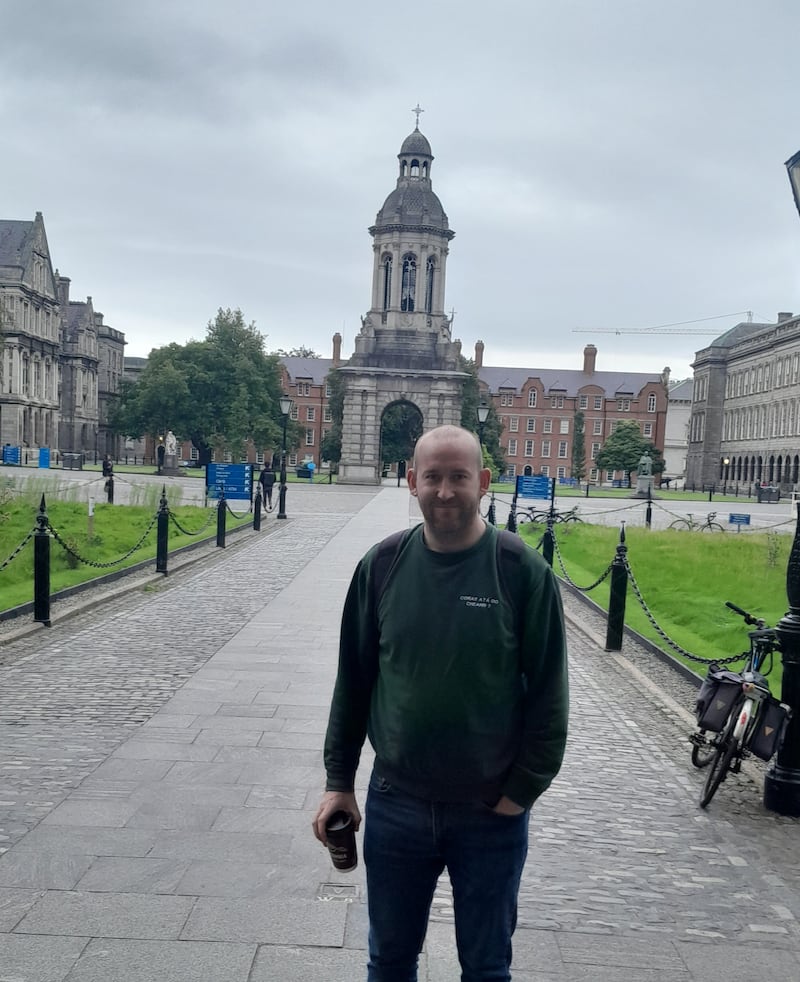The commute is back. The pandemic days of working solely from home, for those who were able to, are fading to distant memory as more employees return to the office and other workplaces with increased frequency. Central Statistics Office (CSO) figures released earlier this week show commute times are longest for those living in Co Meath, followed by Co Kildare and Co Wicklow.
Whether it’s by choice or necessity, the impacts of living in Dublin’s commuter belt and travelling a distance to work are real and felt by those making the regular journey.
Suzanne Domotor and her husband Gabor live in Broadford, Co Kildare, with their two young daughters. They both work in Dublin city centre.
“Gabor has always lived in Dublin. He’s from Budapest originally,” Domotor explains. “We were renting in Dublin for a very long time. He was in an apartment in Cabinteely for 14 years. And we were given our eviction notice that they wanted to sell the apartment two Christmases ago. It was very stressful with a little baby.
“We decided that instead of renting somewhere else, because we wouldn’t have been able to afford it, we were going to buy. Obviously, we were just priced out of Dublin, so we came down here. We’re closer to my parents, which is absolutely fabulous.”
While Domotor, who is a legal secretary, is very happy with her new home and surrounding area, she finds the practicalities and logistics of the work commute very challenging. “Working from home has been absolutely wonderful . . . but we’re back in the office three days a week, which has been an incredible struggle on us,” she says.
“My biggest thing would be childcare. When we first came down here, we couldn’t get into creches. We were relying on a lovely childminder close to us, but she wasn’t able to do the long, long hours that we needed, to be able to commute to Dublin.
“It’s one thing being able to afford a house . . . but then it’s actually being able to find someone to look after your kids while you do the huge big trek [to work]. We’d need 12-hour days. Seven to seven, really.”
Although Domotor eventually managed to get her eldest daughter into creche, the hours are still an issue. “I’m technically 9-5.30.” Having to rely on “really, really narrow train or bus times” means that even when she leaves work early, Domotor still doesn’t make it back in time for the creche closing. “Tag-teaming in that way is really difficult.”
Domotor explains it’s not just a case of getting the train and arriving at work. She first drives to the train station in Enfield, catches the train, and then takes the Luas to continue her journey when she arrives in Dublin.
“There’s one train in the morning and one train in the evening at a reasonable hour, otherwise you’re up at the crack of dawn or you’re getting in at 10am. The great thing about the train, even though it’s fiendishly expensive, is actually being . . . able to log on, on the train.”

That though, Domotor explains, depends on “if you get a seat”. “The trains are so jammers,” she says, explaining the difficulties of being on a packed train last year while pregnant with her daughter, Amelie, and struggling with morning sickness and pelvic girdle pain.
“The mornings are ridiculous. You’re getting up at the crack of dawn before everyone else to get everyone prepared and out the door. You’re frazzled by the time you get into work, not even early – by the skin of your teeth, if you’re on time, even though you’ve been up well before anyone who lives much closer.”
[ Final shape of hybrid office work slowly coming into focusOpens in new window ]
Domotor says she and her husband will need to reshuffle their hours to cope with her return from maternity leave next year. “It’s just not feasible the way it is. When you’re leaving at 7am and coming home at 7pm, you’re missing your kids growing up.”
Moving back closer to work is not an option. “We couldn’t. We absolutely couldn’t . . . look at house prices.” The commute has also contributed to the couple’s decision not to have any more children, although she would like to. “We just can’t, that’s it. We’ve come to terms with that,” Domotor says. “The commute, missing out on them and childcare fees” means their family must be complete.
Dr Ciara Murphy is a drama lecturer in Technological University Dublin. She commutes from her home in Wexford to Dublin most days.
“The train journey is about 2½ hours each way,” Murphy explains. The five hours spent on trains are not the only part of her commute. Murphy cycles to the train station from her home, brings a fold-up bike with her and then when she arrives in Dublin, cycles from the train station to Grangegorman, adding another 20 minutes to her journey, each way.
Murphy says “financial reasons” are why she lives in Wexford while working in Dublin. “We bought a house down here in 2021 and we just wouldn’t have been able to afford something equivalent in Dublin. I’m from Wexford town and at that time we were both working from home”.
“The way academia works, you’re not doing it five days a week, 52 weeks of the year,” Murphy says. “So you can kind of make it work.”
“I have a car and I have contemplated driving. Off peak it does take shorter in the car, but to drive to Dublin city centre from Wexford, is not only a heartbreaking experience, it’s so expensive and stressful.”
Murphy’s annual tax-saver ticket costs about €60 per week, she estimates. “When I look at my mortgage payment compared to what I’d be paying for the equivalent in Dublin, it doesn’t even come close. Ideally, I’d be living where I work, but it’s just not feasible the way housing is at the moment.”
Murphy’s partner also works in Dublin. “I have to say if I couldn’t do it by train, I wouldn’t be able to do it,” she says. “If I’d to drive or get on the bus and sit in traffic twice a day, it’s not possible. Where at least I can do my meetings on the train, I can answer my email. I can get my prep done.” Murphy is also aware of the environmental impact of living far from work, another reason she prefers to use public transport.
“The aim is to get back to Dublin. That’s where we’d both like to be living,” she says. “In 10 years’ time, maybe things will all be different and maybe interest rates will have calmed down.”
[ A 270km daily trip to college: The rise of the long-distance commuting studentOpens in new window ]
Because the couple don’t plan to have children, Murphy says they have “a certain flexibility I don’t think other families have”. But while the couple can sometimes travel together to Dublin, she concedes the commute can also place pressure on relationships. “You are wrecked when doing particularly longer commutes and you’re just not fit for having a conversation with anybody.”
And she feels frustration that even though the couple have good jobs, they can’t afford to live near where they work. “I do think it’s a failure of policy. We aren’t earning mega money, but we’re earning good money between us.”
Sam Dobbins is studying to become a teacher at Trinity College Dublin. He lives with his wife in Ashbourne, Co Meath. He’s on the bus on the way to Dublin, he says when taking a phone call.
“It was supposed to arrive at 3.20pm. It didn’t come until 3.55pm. That’s a regular occurrence” he says, the frustration evident in his tone.
“If I have a lecture in the morning at nine, I’d have to get a bus at around 6.45, when I should be able to get a bus at 8.00. But I was getting a bus at 8.00 and I wasn’t getting in until 9.30 or 9.45 because it was either late or it didn’t show up.”
The commute and unreliability of public transport is impacting the college experience, Dobbins says. “That’s time I could be spending doing assignments. I’ve been in college since the last week of August and we’ve only gone for drinks twice because people [fellow commuters] are under a lot of pressure.”

As part of his studies Dobbins is doing a placement in a school, and he drives there. But driving to Trinity isn’t an option because of the cost of parking, he says. “Driving into the city centre would be an absolute nightmare timewise as well. I’m probably better off knowing the bus isn’t reliable and leaving an hour early instead of driving in, still having to leave an hour early and then paying for a full day’s parking as well.”
Looking to the future, Dobbins says he’ll be “looking for a job anywhere outside Dublin”, as he doesn’t see the commute as being sustainable long term. “The long-term plan is to look for something west,” he says.
Dobbins and his wife have decided not to have a family. “It’s the whole cost of living, housing prices, everything. It’d be unfair to say it was ... transport related, but I wouldn’t like to have my kids doing this.”
Aoife Gregg Anderson lives in Newtownmountkennedy, Co Wicklow. She works two or three days per week in central Dublin.
Flexibility is essential to making the commute work, Gregg Anderson says. “Anything that involves going to the airport or town, you either go before 7am or after 9am. To get home at a reasonable time, you either leave before 4pm or after 6pm,” she says.
“The buses are packed by the time they get to Newtown from Wicklow and the Dart is packed as well. I couldn’t do what I do if I didn’t have a car or if I was told, ‘9 o’clock, you’ve to be at your desk five days per week’.”
“When I do my office days I would leave after 6,″ she explains. But this means her children are in bed by the time she gets home from work.
[ Commuter hell: ‘My daily commute is affecting my mental health’Opens in new window ]
Gregg Anderson says she outsources some things to try to make life more manageable and to allow for the long days that she works in the office. “I have a cleaner, a childminder for my son. It’s a juggle, a constant spinning ball,” she says, explaining that she “tag teams” with her husband who can work from home more than she can.
Yet in spite of this, Gregg Anderson says she wouldn’t consider moving to Dublin and closer to her job. She has very deliberately chosen where she lives. “It’s a wonderful place to live,” she says. “I want to be near to my parents.
“This is as far as I would go because I have a Dart option, because I have a Dublin Bus service.” She drives to work, still however, “because it’s quicker than the public transport options. It’s always been like that. There’s no incentive to get public transport on my side.”
Gregg Anderson estimates she spends about €50 on fuel every week, commuting to work. There are also challenges around creche closing hours with the longer commute. The creche closes at six, making the journey home a finely balanced affair. Any delays and she’ll struggle to make it.
Aoife Butler also lives in Wicklow. She commutes from Greystones to Grangegorman where her job as a youth advocate is based, and where she also studies.
“I live in Greystones because that’s where I’m from. That’s where my family, my network, my community, my friends are,” she says. Because Butler doesn’t always work during peak traffic hours, she describes the commute as “doable”. “Any closer into town would have cost me more as well.”

Butler admits the commute does have an impact on her life. “The days I have to be in Grangegorman for 9am, I need to be gone by 6.40 to make sure I’m in at that time. Any later it’s completely hit and miss if you’re going to be in on time.”
“One of the reasons I switched careers – because I was doing 9-5.30 Monday to Friday in the corporate world – is to avoid spending three or four hours a day in traffic heading into Dublin,“ she says.
“Activities go out the window when you’re commuting,” Butler says, but that’s “going to change”. “For work-life balance you have to have those things, it’s important. I’m 44 now. I think I spent the guts of my 20s and 30s not realising that. But when you do finally understand the importance of the work-life balance, something’s got to give.”
- Sign up for push alerts and have the best news, analysis and comment delivered directly to your phone
- Find The Irish Times on WhatsApp and stay up to date
- Our In The News podcast is now published daily - Find the latest episode here











